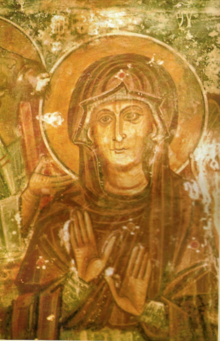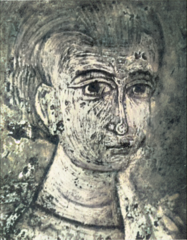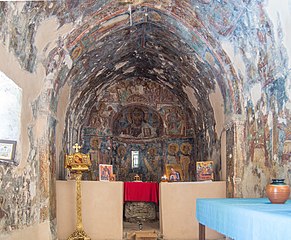Ioannis Pagomenos
Ioannis Pagomenos | |
|---|---|
 Virgin | |
| Born | 1285 Heraklion, Crete |
| Died | 1350 Crete |
| Nationality | Greek |
| Movement | Byzantine Iconography Pre-Cretan School |
Ioannis Pagomenos (Greek: Ιωάννης Παγωμένος, 1285–1350), was a Greek painter. He followed the Byzantine style of painting. Ioannis was active in Crete. He is one of the most important painters in Crete because he created the framework for the Cretan School. His frescos can be found in different portions of Crete. His art influenced Andreas Pavias, Angelos Akotantos, Andreas Ritzos, and Nikolaos Tzafouris. He had a very active workshop during the 14th century. His son Nikolaos was also a famous painter.[1][2][3]
History[]
Pagomenos was born in Heraklion. He either trained in Crete or somewhere in the Byzantine Empire. Other active painters at the time were Manuel Panselinos and Michael Astrapas and Eutychios. The biggest portion of his work is in southwest Crete. Mainly in the Selino district. The only record of his life is in the churches he signed. He was active for roughly thirty-four years. His first signature can be found in the Church of Agios Georgios. It is located in the village of Komitades Sfakia. He painted the church around 1313–4. The last painting with his signature can be found in 1347. It was in the Church of the Dormition at Prodromi Sfakidia in the Selino district. His son Nikolaos also signed some of the frescos.[4][5]
Gallery[]

Crucifixion of Jesus

Saint Demetrios

Signature Plaque

Agios Stephanos

Fresco of St. George in Anydroi church of St. George

Fresco of Saint John
Notable works[]
- Saint (Agios) Georgios in Komitades, Sfakia 1313-4
- Saint (Agios) Nikolaos at Moni, Selino 1315
- Theotokos in Alikampos, Apokoronas (1315-16)
- Saint (Agios) Georgios in Anidros, Selino 1323
- Saint (Agios) Nikolaos in Maza, Apokoronas 1325-6
- Michael the Archangel in Kandanos, Selino 1327-8
- Church of Agios Ioannis in Kandanos 1328-9
- Agios Panteleimon in Prodromi
- The Virgin Mother of God in Kadros, Selino, in the community of Kakodikio
- Panagia in Kakodiki, Selino 1331-2
- Panagia in the Village of Prodromi Skafidia, Selino 1347
See also[]
References[]
- ^ Lymberopoulou, Angeliki (2010). Fourteenth-century Regional Cretan Church Decoration: the Case of the Painter Pagomenos and his Clientele. In: Towards Rewriting? New Approaches to Byzantine Art and Archaeology. Krakow Symposium on Byzantine Art and Archaeology. Krakow, Poland: Krakow Symposium on Byzantine Art and Archaeology. p. 8-10.
- ^ Lymberopoulou, Angeliki (2003). L'artista a Bisanzio E Nel Mondo Cristiano-orientale. Pisa, Italy: Edizioni della Normale. p. 61.
- ^ Kalokiri, K.D. (1957). Ioannis Pagomenos The Byzantine Painter (PDF). Athens, Greece: University of Thessaly Institutional Repository. pp. 47–48.
- ^ Staff Writers (June 18, 2021). "Salvaging Crete Preserving the Legacy of the Artist Ioannis Pagomenos". Washington University in St. Louis. Retrieved June 18, 2021.
- ^ Kalokiri, 1957, pp. 47-48
- People of medieval Crete
- 1285 births
- 1350 deaths
- Byzantine painters
- Christian iconography
- 13th-century births
- 14th-century deaths
- 13th-century Byzantine people
- 14th-century Byzantine people
- 13th-century Greek people
- 14th-century Greek people
- 13th-century Greek painters
- 14th-century Greek painters





